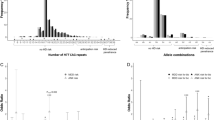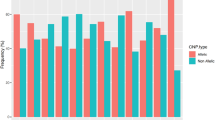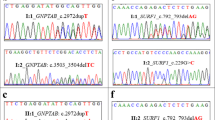Abstract
The aggregation of patients with Huntington's disease (HD) around Lake Maracaibo, Zulia State, Venezuela, is widely recognized, but the epidemiology of HD in the whole country is relatively unstudied. We have examined 279 individuals from 60 unrelated affected families residing in various areas of Venezuela for the presence of CAG repeats and other features associated with HD. The number of expanded repeats in 139 carriers varied from 35 to 112. Based on our examination of 71 symptomatic individuals, we developed a log-transformed regression equation, y = −0.0238x + 2.6616, to enable the prediction of age of onset in asymptomatic carriers. Intragenic haplotypes were constructed with two VNTRs (variable number of tandem repeats) and two SNPs (single nucleotide polymorphisms) in the promoter region as well as CCG repeat and Δ2642 polymorphisms to assess kinship between families. In 43 of 45 tested families, the haplotype on the mutated chromosome was 1;G;C;7;(A). The other haplotypes observed, 1;G;C;7;(B) and 4;G;C;7;(A), were of Peruvian and French origins, respectively. The geographic source of the first affected ancestor was assessed in 54 families from 15 different states. Residents of the states of Miranda, Lara and Táchira, excluding those of Zulia, had a mutated allele prevalence five- to ninefold higher than that of other areas. A low (approx. 1/200,000) prevalence, a wide-spread distribution with aggregation in some states and a likely remote European Caucasoid origin are defining epidemiologic features of HD in Venezuela.
Similar content being viewed by others
Log in or create a free account to read this content
Gain free access to this article, as well as selected content from this journal and more on nature.com
or
Change history
01 April 2008
In Table 2, a column heading was inadvertently omitted. Corrected table is as follows:
References
Alfonso HS, Daza J, Carbonell C, Brokate F, Caiffa H (1996) Caracterización de las secuencias polimórficas de tripletes CAG y CCG del gen de la enfermedad de Huntington en familias colombianas. Acta Méd Colomb 12:70–75
Almqvist E, Spence N, Nichol K, Andrew SE, Vesa J, Peltonen L, Anvret M, Goto J, Kanazawa I, Goldberg YP, Hayden MR (1995) Ancestral differences in the distribution of the delta 2642 glutamic acid polymorphism is associated with varying CAG repeat lengths on normal chromosomes: insights into the genetic evolution of Huntington disease. Hum Mol Genet 4:207–214
Alonso ME, Yescas P, Cisneros B, Martínez C, Silva G, Ochoa A, Montanez C (1997) Analysis of the (CAG)n repeat causing Huntington’s disease in a Mexican population. Clin Genet 51:225–230
Andresen JM, Gayán J, Cherny SS, Brocklebank D, Alkorta-Aranburu G, Addis EA, The US–Venezuelan Collaborative Research Group, Cardon LR, Housman DE, Wexler NS (2007) Replication of twelve association studies for Huntington’s disease residual age of onset in large Venezuelan kindreds. J Med Genet 44:44–50
Andrew S, Goldberg YP, Theilmann J, Zeisler J, Hayden MR (1994) A CCG repeat polymorphism adjacent to the CAG repeat in the Huntington disease gene: implications for diagnostic accuracy and predictive testing. Hum Mol Genet 3:65–67
Arias S (1994) Selective detection among the high risk populations, instead of mass screening, proposed for countries with various homogeneous origins, and a stratified distribution of abnormal genes. In: Farriaux JP, Dhondt L (eds) New horizons in neonatal screening. Excerpta Med Int Cong Ser 1041:97–100
Arias S, Paradisi I (1996) Supratipos (=haplotipos) con marcadores de IDUA (intrón 2 y exón 3) y D4S43, para identificar alelos anormales en IT15 (Corea de Huntington) y en IDUA (mucopolisacaridosis IH). Acta Cient Venez 47[Suppl 1]:60
Avila-Girón R (1973) Medical and social aspects of Huntington’s chorea in the state of Zulia, Venezuela. Adv Neurol 1:261–266
Bonilla E (1991) ¿Por qué es importante el estudio de la Enfermedad de Huntington en Venezuela? Invest Clin 32:107–108
Brandt B, Greger V, Yandell D, Passarge E, Horsthemke B (1992) A simple and nonradioactive method for detecting the Rb1.20 DNA polymorphism in the retinoblastoma gene. Am J Hum Genet 51:1450–1451
Brinkman R, Mezei M, Theilmann J, Almqvist E, Hayden M (1997) The likelihood of being affected with Huntington disease by a particular age, for a specific CAG size. Am J Hum Genet 60:1202–1210
Coles R, Leggo J, Rubinsztein DC (1997) Analysis of the 5′ upstream sequence of the Huntington’s disease (HD) gene shows six new rare alleles which are unrelated to the age at onset of HD. J Med Genet 34:371–374
Cuba JM (1986) Un foyer de Chorée de Huntington au Pérou. Rev Neurol (Paris) 142:151–153
Cuba JM, Torres L (1989) Huit arbres généalogiques de Chorée de Huntington à Cañete (Pérou). Rev Neurol (Paris) 145:482–484
FIDD (Frequency of Inherited Disorders Database) (2007) Available at: http://www.uwcm.ac.uk/uwcm/mg/fidd
Friedman KJ, Highsmith WE, Prior TW, Perry T, Silverman LM (1990) Cystic fibrosis deletion mutation detected by PCR-mediated site-directed mutagenesis. Clin Chem 36:695–696
García-Planells JG, Burguera JA, Solís P, Millán JM, Ginestar D, Palau F, Espinos C (2005) Ancient origin of the CAG expansion causing Huntington disease in a Spanish population. Hum Mutat 25:453–459
Gusella JF, Wexler NS, Conneally PM, Naylor SL, Anderson MA, Tanzi RE, Watkins PC, Otttina K, Wallace MR, Sakaguchi AY, Young AB, Shoulson I, Bonilla E, Martin JB (1983) A polymorphic marker genetically linked to Huntington’s disease. Nature 306:234–238
Gusella JF, Tanzi R, Anderson MA, Hobbs W, Gibbons K, Raschtchian R, Gilliam TC, Wallace MR, Wexler NS, Conneally PM (1984) DNA markers for nervous system diseases. Science 225:1320–1326
HDCG (1993) A novel gene containing a trinucleotide repeat that is unstable in Huntington’s disease chromosomes. The Huntington’s Disease Collaborative Research Group. Cell 72:971–983
Kartsaki E, Spanaki C, Tzagournissakis M, Petsakou A, Moschonas N, MacDonald M, Plaitakis A (2006) Late-onset typical Huntington disease families from Crete have distinct genetic origins. Int J Mol Med 17:335–346
Kolman CJ, Sambuughin N, Bermingham E (1996) Mitochondrial DNA analysis of Mongolian populations and implications for the origin of New World founders. Genetics 142:1321–1334
Kremer B, Goldberg P, Andrew S, Theilmann J, Telenius H, Zeisler J, Squitieri F, Lin B, Basset A, Almqvist E, Bird T, Hayden M (1994) A worldwide study of the Huntington’s disease mutation. N Engl J Med 330:1401–1406
Lahiri D, Nurnberger J (1991) A rapid and non-enzymatic method for the preparation of HMW DNA from blood for RFLP studies. Nucleic Acids Res 19:5444
Masuda N, Goto J, Murayama N, Watanabe M, Kondo I, Kanazawa I (1995) Analysis of triplet repeats in the huntingtin gene in Japanese families affected with Huntington’s disease. J Med Genet 32:701–705
Negrette A (1962) Corea de Huntington. Facultad de Medicina, Universidad del Zulia, Maracaibo
Okun MS, Thommi N (2004) Americo Negrette (1924 to 2003) diagnosing Huntington disease in Venezuela. Neurology 63:340–343
Osorio FE (1996) Los Andes venezolanos. Proceso social y estructura demográfica (1800–1873). Universidad de los Andes, Cons. Publ., Mérida
Penney JB, Young AB, Shoulson I, Starosta-Rubinstein S, Snodgrass SR, Sánchez-Ramos J, Ramos-Arroyo M, Gómez F, Penchaszadeh G, Alvir J (1990) Huntington’s disease in Venezuela: 7 years of follow-up on symptomatic and asymptomatic individuals. Mov Disord 5:93–99
Penney JB, Vonsattel JP, MacDonald ME., Gusella JF, Myers RH (1997) CAG repeat number governs the development rate of pathology in Huntington’s disease. Ann Neurol 41:689–692
Ranen NG, Stine OC, Abbott MH, Sherr M, Codori AM, Chao NI, Chung AS, Pleasant N, Callahan C (1995) Anticipation and instability of IT-15 (CAG)n repeats in parent–offspring pairs with Huntington disease. Am J Hum Genet 57:593–602
Raskin S, Allan N, Teive H, Cardoso F, Santoro M, Levi G, Boy R, Lerena J, Santos V, Janzen-Dück M, Bannach L, Fellander F, Franco A (2000) Huntington disease: DNA analysis in Brazilian population. Arq Neuropsiquiatr 58:977–985
Roff DA, Bentzen P (1989) The statistical analysis of mitochondrial DNA polymorphisms: χ2 and the problem of small samples. Mol Biol Evol 6:539–545
Rubinsztein DC, Leggo J, Goodburn S, Barton DE, Ferguson-Smith MA (1995) Haplotype analysis of the Δ2642 and (CAG)n polymorphisms in the Huntington´s disease (HD) gene provides an explanation for an apparent ‘founder’ HD haplotype. Hum Mol Genet 4:203–206
Rubinsztein DC, Leggo J, Chiano M, Dodge A, Norbury G, Rosser E, Craufurd D (1997) Genotypes at the GluR6 kainate receptor locus are associated with variation in the age of onset of Huntington disease. Proc Natl Acad Sci USA 94:3872–3876
Snell R, MacMillan J, Cheadle J, Fenton I, Lazarou LP, Davies P, MacDonald ME, Gusella JF, Harper PS, Shaw DJ (1993) Relationship between trinucleotide repeat expansion and phenotypic variation in Huntington’s disease. Nat Genet 4:393–397
Squitieri F, Andrew SE, Goldberg YP, Kremer B, Spence N, Zeisler J, Nichol K, Theilmann J, Greeberg J, Goto J, Kanazawa I, Vesa J, Peltonen L, Almqvist E, Anvret M, Telenius H, Lin B, Napolitano G, Morgan K, Hayden MR (1994) DNA haplotype analysis of Huntington disease reveals clues to the origins and mechanisms of CAG expansion and reasons for geographic variations of prevalence. Hum Mol Genet 3:2103–2114
Tokunaga K, Ohashi J, Bannai M, Juji T (2001) Genetic link between Asians and native Americans: evidence from HLA genes and haplotypes. Hum Immunol 62:1001–1008
Torres L, Mori N, Mendoza M, Montoya J, Cuentas M, Domínguez J, Mendoza H, Pérez D, Mazzetti P (2006) Estudio clínico molecular de la enfermedad de Huntington en pacientes del Valle de Cañete-Perú. Diagnóstico 45:102–108
Wexler N, Young A, Tanzi R, Travers H, Starosta-Rubinstein S, Penney J, Snodgrass R, Shoulson I, Gómez F, Ramos Arroyo M, Penchaszadeh G, Moreno H, Gibbons K, Faryniarz A, Hobbs W, Anderson M, Bonilla E, Conneally P, Gusella J (1987) Homozygotes for Huntington’s disease. Nature 326:194–197
Wexler NS, Lorimer J, Porter J, Gómez F, Moskowitz C, Shackell E, Marder K, Penchaszadeh G, Roberts SA, Gayán J, Brocklebank D, Cherny SS, Cardon LR, Gray J, Dlouhy SR, Wiktorski S, Hodes ME, Conneally PM, Penney JB, Gusella J, Cha JH, Irizarry M, Rosas D, Hersch S, Hollingsworth Z, MacDonald M, Young AB, Andresen JM, Housman DE, De Young MM, Bonilla E, Stillings T, Negrette A, Snodgrass SR, Martinez-Jaurrieta MD, Ramos-Arroyo MA, Bickham J, Ramos JS, Marshall F, Shoulson I, Rey GJ, Feigin A, Arnheim N, Acevedo-Cruz A, Acosta L, Alvir J, Fischbeck K, Thompson LM, Young A, Dure L, O’Brien CJ, Paulsen J, Brickman A, Krch D, Peery S, Hogarth P, Higgins DS Jr, Landwehrmeyer B, U.S.-Venezuela Collaborative Research Project (2004) Venezuelan kindreds reveal that genetic and environmental factors modulate Huntington’s disease age of onset. Proc Natl Acad Sci USA 101:3498–3503
Young AB, Shoulson I, Penney JB, Starosta-Rubinstein S, Gómez F, Travers H, Ramos-Arroyo MA, Snodgrass SR, Bonilla E, Moreno H (1986) Huntington’s disease in Venezuela: neurological features and functional decline. Neurology 36:244–249
Acknowledgments
We are grateful to all of the families who generously gave their consent, time and patience during the long process of convening these data, and to the various physicians who sent us their patients, in particular Dr. Roberto Weiser from Caracas and the Venezuelan Association for Huntington Disease (AVEHUN). Our thanks are extended to Greta Rodríguez-Arroyo for her assistance with the SPSS program and to Miss Elena Mylonás, who efficiently processed three of the polymorphisms.
Author information
Authors and Affiliations
Corresponding author
Rights and permissions
About this article
Cite this article
Paradisi, I., Hernández, A. & Arias, S. Huntington disease mutation in Venezuela: age of onset, haplotype analyses and geographic aggregation. J Hum Genet 53, 127–135 (2008). https://doi.org/10.1007/s10038-007-0227-1
Received:
Accepted:
Published:
Issue date:
DOI: https://doi.org/10.1007/s10038-007-0227-1
Keywords
This article is cited by
-
The known burden of Huntington disease in the North of Scotland: prevalence of manifest and identified pre-symptomatic gene expansion carriers in the molecular era
Journal of Neurology (2021)
-
The targetable A1 Huntington disease haplotype has distinct Amerindian and European origins in Latin America
European Journal of Human Genetics (2017)
-
Regional research priorities in brain and nervous system disorders
Nature (2015)
-
Huntington disease-like 2 (HDL2) in Venezuela: frequency and ethnic origin
Journal of Human Genetics (2013)
-
HTT haplotypes contribute to differences in Huntington disease prevalence between Europe and East Asia
European Journal of Human Genetics (2011)



